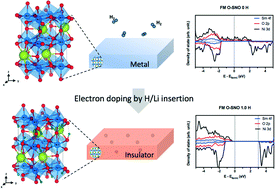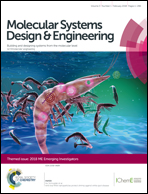Metal-to-insulator transition in SmNiO3 induced by chemical doping: a first principles study†
Abstract
Rare-earth perovskite RNiO3 (R = Sm, Pr, Nd, etc.) has been investigated during the past decades due to a variety of tunable physical properties such as electrical conductivity and optical properties. Chemical doping in SmNiO3 was confirmed by experiments as a new way to drive metal-to-insulator transition under isothermal conditions. However, detailed crystal and electronic structure changes remain unknown. Here, we applied first principles density functional theory (DFT) to understand the mechanism of chemical doping with H and Li in SmNiO3. We showed that the DFT+U method with the PBEsol functional and Ueff = 2 eV produced results in good agreement with experiments for both insulating and metallic phases of SmNiO3. We examined the changes in geometry and electronic structures at various hydrogen and lithium doping concentration up to the experimental 1 : 1 H(Li) : Ni ratio. We observed a band gap opening of ∼3.0 eV (predicted by HSE06) at H : Ni = 1 : 1, in good agreement with experiments. We further investigated the migration of H or Li along the [001] direction of SmNiO3. We found a migration barrier of ∼0.3 eV for hydrogen and ∼0.4 eV for lithium. These current findings pave the way for future theoretical and experimental investigation to develop efficient metal–insulator switching devices using rare earth perovskites.

- This article is part of the themed collection: MSDE Emerging Investigators 2018


 Please wait while we load your content...
Please wait while we load your content...